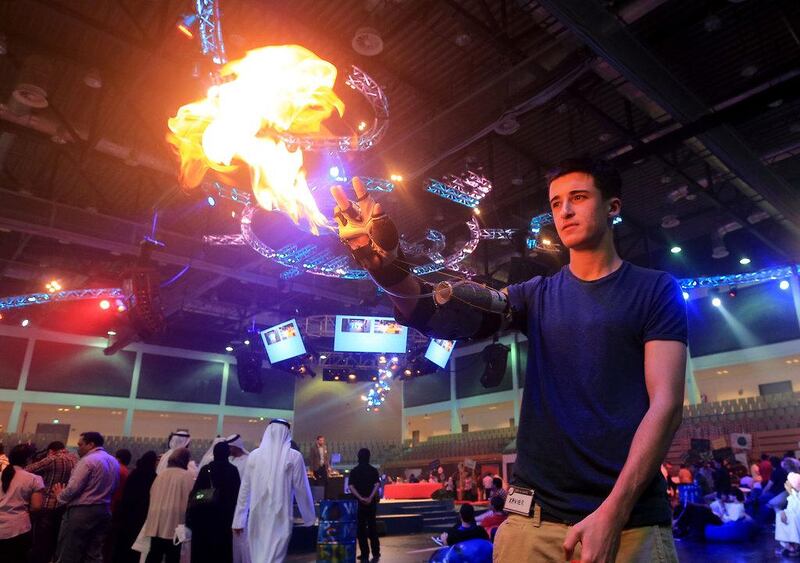ABU DHABI // A giant robotic arm that gives it users super strength, a homemade flame thrower and a sensor system that could reduce the number of road traffic accidents were among more than 150 homegrown technology projects on display at an inaugural event for do-it-yourself enthusiasts.
Innovator 2014 brought together tinkerers, tech enthusiasts, crafters, car tuners, IT programmers and designers, while also featuring shows, speakers and interactive experiences.
Arjun Bhorkar, 12, of Millenium School, Dubai, stood proudly behind a table showcasing two of his creations: an RC Nitro Car – a giant robotic four-wheeled vehicle powered by nitrox – and the Quad Copter, a helicopter powered by four propellers.
Arjun dreamed up the Quad Copter when some friends spoke about wanting a robotic aerial machine that could hold the weight of two video cameras.
“I fly it using a remote control which I made,” he said. “It has acrobatic quality too so can do things such as loops and it has an approximate fly time of 20 minutes, a thrust of 8 kilograms and has LED strips on the side to you can see its flight.”
The Indian expatriate, a previous winner of World Robot Olympiad Arabia, a global robotic competition for youngsters, started making his own toys as a child before moving on to bigger and better creations.
“It is impossible to keep up with him,” admitted his mother, Sharon. “He is amazing.”
Arjun was one of 400 innovators who showed off their creations as part of the Abu Dhabi Technology Development Committee event.
Mohammed Awadallah, 21, a Palestinian trainee at the Petroleum Institute, was one of five creators behind the Exoskeletal Arm – a device that gives its users the ability to lift three times what the average human can.
Mohammed and his team used fluidic muscle and stainless steel to create the invention, a stepping stone towards their ultimately hope – to build a full Iron Man-type body suit.
They hope their invention could be used to help those with muscular injuries or those at risk of joint strain because of jobs that require constant heavy lifting.
The Exoskeletal Arm was not the only to be influenced by the comic book superhero Iron Man.
Zavier Goby, 17, wowed the crowds with his homemade flame thrower, built using a piece of brass, paper clips, a pen cap, butane canister, construction glove and a piece of string.
He was inspired by the film Iron Man 3 and after a few prototypes – which left him with some minor burns – perfected his contraption.
“I thought it would be cool,” said Zavier, admitting his invention does not have any purpose other than for fun.
In addition to the fun crowd-pleasers, other inventors used the event to showcase creations with a serious message.
Emirati Khalifa Al Shehhi, 17, from Abu Dhabi, created the Drivers Fatigue Detection System in a bid to cut the number of sleep-related crashes on the region’s roads.
“About 17 percent of accidents happen in Abu Dhabi because drivers are either asleep or tired,” he said.
The system uses sensors on the wheel, as well as eye sensors, to detect when a driver’s eyelids are frequently closing or if a driver’s grip on the steering wheel becomes slack.
“If a driver is deemed tired or sleeping it will sound a spoken alarm,” said Khalifa.
Syrian Monther Al Shehabi, 27, was among a team of Ajman University students who created a Smart Guidance System for the Blind.
It works using a five-sensor belt and helmet, guiding people with visual impairments around obstacles as they are making their way from one point to another.
The creation, which drew a large amount of interest from the crowd and has won praise from Ahmad Karim, of the Emirates Association of the Visually Impaired, aims to give more independence to the blind.
Jordanian school pupil Farah Jamel, 15, and Syrian Nour Sammani, 14, used broken, unwanted and unused gadgets to create artistic home decorations.
A table showcased their wares: melted plastic spoons were transformed into pretty flower decorations, a bag made from milk bottles, and a decorative mirror frame created using an egg carton.
Other inventors’ creations included a fan-assisted umbrella, a keep-cool jacket and solar powered motor vehicles.
The first such fair in the country, Innovators 2014, sponsored by The National, was staged at Zayed Sports City in the First Gulf Bank Area, which had been transformed into part giant, smoky chemistry lab and part artists’ studio.
“We wanted to establish a platform for the DIYers and innovators to connect with each other and to share their experiences and to share their innovations to the public,” said Majid Al Mail, senior manager at TDC who headed Innovator.
The free, one-day event event attracted attracted hundreds of visitors, including Shireen Ahmed, 29, and her son Fares, 5.
“I want to encourage an interest in science in Fares,” said Mrs Ahmed, from Abu Dhabi. “I think he is enjoying it.”
The event, which will return to the emirate next year, ended with an awards ceremony for the two best inventions after a panel of judges whittled down the entries.
The People’s Choice award went to Intelligent Greenhouse Systems, a project by a group of students from the Higher Colleges of Technology in Ras Al Khaimah. The students proposed that their greenhouse could be used in the UAE to remove the need for agriculture and energy conservation. The prototype includes an automated cooling system and a solar-powered hydroponic system. The Innovator of the year was E-Motion – a device designed to aid emotional communication between an autistic child and their parent or primary caregiver, using motion sensors.
jbell@thenational.ae






